السعرات الحرارية لأنواع الأجبان المختلفة
Download as pptx, pdf2 likes1,222 views
تتناول الوثيقة السعرات الحرارية لأنواع مختلفة من الأجبان، حيث يحدد المحتوى الحراري لكل نوع بناءً على 25 جرام. على سبيل المثال، تحتوي جبنة فيتا على 75 سعر حراري، بينما تحتوي جبنة بارميزان على 130 سعر حراري.
1 of 13
Downloaded 26 times







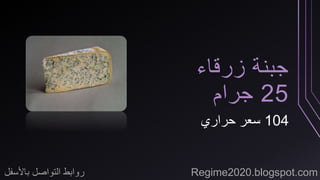
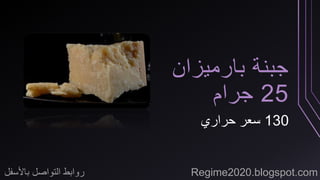
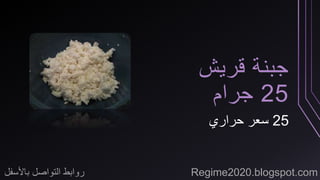
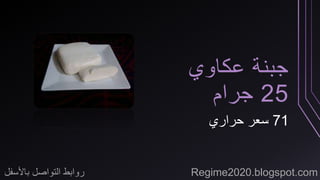

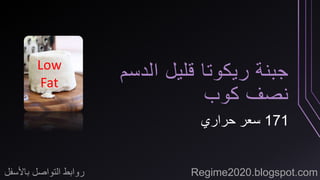
Ad
Recommended
السعرات الحرارية لأنواع الخبز و الأرز و النشويات المختلفة
السعرات الحرارية لأنواع الخبز و الأرز و النشويات المختلفةد.أبونور أحمدي
��
تتضمن الوثيقة معلومات عن السعرات الحرارية لمجموعة متنوعة من أنواع الخبز والأرز والنشويات. على سبيل المثال، يحتوي الخبز الأبيض على 200 سعر حراري لكل رغيف، بينما الأرز الأبيض يحتوي على 230 سعر حراري لكل كوب. كما تقدم الوثيقة تفاصيل عن عدد السعرات الحرارية لأطعمة أخرى مثل المكرونة والعسل والفلافل.السعرات الحرارية لأنواع الحليب المختلفة
السعرات الحرارية لأنواع الحليب المختلفةد.أبونور أحمدي
��
الوثيقة تقدم معلومات عن السعرات الحرارية لأنواع مختلفة من الحليب، حيث يحتوي كوب الحليب الكامل الدسم على 150 سعر حراري، بينما كوب حليب الماعز يحتوي على 264 سعر حراري. كما تتضمن السعرات الحرارية لأشكال أخرى مثل الحليب المكثف والحليب البودرة. الوثيقة تحتوي على تفاصيل إضافية حول حليب الشوكولاتة والفراولة.كتاب انقاص الوزن فى 60 يوم
كتاب انقاص الوزن فى 60 يومenqlap
��
تقدم الوثيقة برنامجًا لتخفيض الوزن بمقدار 10 كيلوجرامات خلال 6 أيام، مستعرضة الإرشادات والأطعمة المسموحة والممنوعة. يتضمن البرنامج وجبات يومية مقسمة على أربعة أقسام، كل منها يستمر 51 يومًا، مع يومين راحة بين كل قسم. كما تشمل الوثيقة نصائح عامة لدعم نجاح الحمية والتخسيس.ريجيم المناسبات السريع في أسبوع
ريجيم المناسبات السريع في أسبوعد.أبونور أحمدي
��
هذا الوثيقة تتناول نظام غذائي لمدة أسبوع، يتضمن وجبات الإفطار والغداء والعشاء. يتضمن النظام خيارات صحية مثل الخبز المحمص والمشويات والفواكه بالإضافة إلى شرب العصائر. يُشدد على تجنب تناول الموز والحصول على استشارة طبية قبل اتباع النظام.حلقة من النشويات عن حساب احتياجات النشويات اليومية
حلقة من النشويات عن حساب احتياجات النشويات اليوميةد.أبونور أحمدي
��
الفيديو يتحدث عن كيفية حساب احتياجات الفرد اليومية من النشويات والسعرات الحرارية. يتم تقديم روابط لمصادر إضافية للمساعدة في حساب الكميات المطلوبة. يتم توجيه المشاهدين إلى تفاصيل أكثر في الوصف أسفل الفيديو.My Carbohydrate Guide
My Carbohydrate GuideTFMG
��
This document provides information about carbohydrates and managing blood glucose levels for people with diabetes. It defines carbohydrates and explains why people with diabetes need to pay attention to foods containing carbs. The document outlines blood glucose and A1C targets and recommends how many carb choices or grams of carbs people should aim to eat per meal and snack depending on their gender. It provides tips for reading food labels to count carbs and examples of common foods and their carb amounts.Carbo Counting and Food Labelling
Carbo Counting and Food LabellingDitta Cempaka Pane
��
Dokumen tersebut membahas tentang pentingnya mengontrol asupan karbohidrat untuk mengontrol kadar gula darah, dengan menekankan pada jumlah karbohidrat yang dikonsumsi pada setiap waktu makan. Dokumen tersebut juga membahas cara melakukan perencanaan makanan dengan memperhatikan sumber karbohidrat, menghitung gram karbohidrat setiap sajian, serta membaca dan memahami label informasi gizi pada produk makanan.Carbohydrate Counting
Carbohydrate CountingEmily Todhunter
��
The document outlines carbohydrate counting as a strategy for managing blood glucose levels in individuals with diabetes, emphasizing the balance between food intake, medications, and physical activity. It provides guidelines for meal planning, including recommended macronutrient distributions, carbohydrate servings per meal, and the importance of fiber and protein intake. Additionally, it details the effects of alcohol and exercise on blood sugar levels, alongside treatment strategies for hypoglycemia.Insulin therapy: art of initiation and titration
Insulin therapy: art of initiation and titration Saikumar Dunga
��
The document outlines guidelines for initiating and titrating insulin therapy for type 2 diabetes. It recommends starting with either bedtime intermediate-acting or morning/bedtime long-acting insulin, and titrating the dose to reach fasting glucose targets. If HbA1c remains above 7% after 2-3 months, additional injections of rapid-acting insulin should be added at mealtimes based on pre-meal glucose levels. Further intensification, such as checking postprandial levels and adjusting prandial insulin, is recommended if HbA1c is still not at target. The guidelines provide a step-by-step approach to optimizing insulin regimens based on glucose monitoring.1. Insuline and Anti diabetics
1. Insuline and Anti diabeticsMirza Anwar Baig
��
This document outlines a lecture on diabetes and antidiabetic drugs. It discusses the synthesis, mechanism of action, and role of insulin. It also covers the diagnosis and symptoms of insulin-related disorders, classification of antidiabetic drugs and their mechanisms of action, pharmacotherapeutics of diabetic disorders, and types and management of diabetes mellitus. The document is compiled by Prof. Anwar Baig of Anjuman I Islam's Kalsekar Technical Campus School of Pharmacy.Carbohydrate counting final
Carbohydrate counting finalmariadelatorre
��
This document provides information and guidelines for carbohydrate counting for people with diabetes. It explains that carbohydrate counting helps control blood glucose levels by balancing carbohydrate intake with insulin. Foods like breads, fruits and starchy vegetables contain carbohydrates and should be counted in servings of about 15 grams each. The document also includes food lists that show common portion sizes for a single carbohydrate serving and sample meal plans demonstrating how to incorporate the recommended number of servings at meals and snacks.Carbohydrate Counting for insulin dose adjustment
Carbohydrate Counting for insulin dose adjustmentltejas86
��
The document by Tejas Limaye outlines carbohydrate counting as a method for managing diabetes by allowing individuals to estimate carbohydrate intake and adjust insulin doses accordingly. It discusses the importance of being aware of carbohydrate sources, estimating their content, and calculating required insulin based on carb intake and blood sugar levels. Practical tips and considerations for effective carb counting and insulin administration are also provided.Carbohydrate Counting
Carbohydrate Countingjeska62
��
Carbohydrate counting is a meal planning approach for diabetes that helps manage glucose levels by teaching individuals to measure the amount of carbohydrates (CHO) consumed. There are two primary methods: CHO gram counting and the CHO exchange system, which assigns specific food groups to equivalent carbohydrate portions. A balanced diet, consisting of varied nutrients and regular meal times, is essential for effective diabetes management, emphasizing moderation rather than restriction.Basic carbohydrate counting final
Basic carbohydrate counting finalHaifaa Abdulsalam
��
Carbohydrate counting is an effective meal planning method that was used in the Diabetes Control and Complications Trial. It involves assessing a patient's needs, developing an optimal carbohydrate intake pattern based on lifestyle and schedule, and teaching patients how to achieve euglycemia through various carbohydrate intake patterns. Summarizing key points from the document, carbohydrate counting decreases A1C by 1-2% in people with diabetes, achieves and maintains target blood glucose and lipid levels, and prevents or slows chronic diabetes complications by modifying nutrient intake and lifestyle.اوجاع ليل السكر محاضرة تثقيفية لمرضي المستشفي
اوجاع ليل السكر محاضرة تثقيفية لمرضي المستشفيDr. Adel El Naggar
��
يتناول المستند التعريف بمرض السكري، أسبابه، أنواعه، وأهمية الوقاية والعلاج منه. يوضح أن مرض السكري يعد مرضًا مزمنًا يتسبب في عجز البنكرياس عن إنتاج الأنسولين بشكل كافٍ، مما يؤدي إلى زيادة مستويات السكر في الدم. كما يتطرق المستند إلى مضاعفات السكري وطرق العلاج المختلفة، بما في ذلك الأنسولين والأدوية الأخرى وأنظمة الغذاء والرياضة.Calculating insulin dose
Calculating insulin doseUniv. of Tripoli
��
الوثيقة تتناول كيفية حساب جرعة الأنسولين، مميزة بين الأنسولين القاعدي والبولس. الأنسولين القاعدي يُستخدم للحفاظ على مستويات السكر في الدم بين الوجبات وفترات الصيام، بينما يُستخدم الأنسولين البولس لتغطية الكربوهيدرات وتصحيح ارتفاع مستويات السكر. تعتمد الجرعات على نسبة الأنسولين إلى الكربوهيدرات وحساسية الفرد تجاه الأنسولين.CHO COUNTING
CHO COUNTINGnutritionistrepublic
��
This document discusses carbohydrate counting for managing diabetes. Carb counting involves following a meal plan that specifies grams of carbs per meal and snack, and using an insulin-to-carb ratio to determine insulin dosage. For those with type 1 diabetes, carb counting helps control blood sugar levels. Those with type 2 diabetes also need to count carbs to control portions and support weight loss through a balanced, limited sugar diet with regular physical activity. Common carb foods are listed along with serving size guidelines to estimate grams of carbohydrates from labels.Oral hypoglycemics
Oral hypoglycemicsAkshay Goel
��
This document summarizes various oral hypoglycemic agents used to treat diabetes. It discusses biguanides like metformin which reduce hepatic glucose production and improve insulin sensitivity. Sulfonylureas work by closing ATP-sensitive potassium channels in beta cells to stimulate insulin secretion but can cause hypoglycemia. Thiazolidinediones are insulin sensitizers that act on PPAR-gamma receptors. Acarbose inhibits alpha-glucosidase to reduce post-prandial hyperglycemia. Newer agents discussed include DPP-4 inhibitors, amylin analogues, SGLT2 inhibitors, and glucokinase activators.Insulin therapy dr shahjadaselim
Insulin therapy dr shahjadaselimBangabandhu Sheikh Mujib Medical University
��
This document provides information on insulin therapy. It discusses what insulin is, how it is secreted normally, and its actions in the body. Insulin deficiency results in hyperglycemia and other metabolic defects. The discovery of insulin by Banting and Best in 1921 revolutionized the treatment of diabetes. Insulin comes in various forms including rapid-acting, short-acting, intermediate-acting, long-acting, and premixed varieties. Common insulin regimens include split-mixed, basal, basal-plus, and basal-bolus. Early initiation of insulin in type 2 diabetes has clinical benefits beyond glycemic control. Barriers to insulin therapy include fear of hypoglycemia and the inconvenience of injection schedules. ProOral hypoglycemic agents in diabetes
Oral hypoglycemic agents in diabetesAditi Panditrao
��
This document discusses oral hypoglycemic agents used to treat diabetes mellitus. It describes several classes of drugs including sulfonylureas, meglitinides, biguanides, thiazolidinediones, alpha-glucosidase inhibitors, bile acid sequestrants, bromocriptine, and SGLT-2 inhibitors. Each drug class is explained in terms of its mechanism of action, pharmacokinetics, efficacy, side effects, and other details. The document provides an overview of current oral medication options for lowering blood glucose levels in diabetes.Oral Hypoglycemic Agents
Oral Hypoglycemic AgentsShanyar Hama Karim
��
The document provides an overview of the pancreas and its role in producing hormones that regulate blood glucose levels. It discusses types of diabetes, including type 1 caused by lack of insulin and type 2 caused by insulin resistance. It describes classes of anti-diabetic medications, including insulin secretagogues like sulfonylureas and meglitinides that stimulate insulin release, and insulin sensitizers like biguanides and thiazolidinediones that improve insulin response without affecting secretion. Common adverse effects and considerations for use are outlined for each drug class.Insulin
InsulinVince Hilarion
��
Insulin is a hormone produced by the pancreas that regulates blood sugar levels. It allows glucose in the bloodstream to enter cells and be used for energy. Without insulin, blood sugar builds up and cells are deprived of energy, leading to serious health issues. Diabetes occurs when the body does not produce enough insulin or the cells do not respond properly to insulin. Historically, insulin was purified from animals but is now commonly produced through recombinant DNA technology using modified bacteria. This process involves isolating the human insulin gene, inserting it into bacterial DNA, and causing the bacteria to express and mass produce human insulin.Insulin
InsulinDr.M.Prasad Naidu
��
The document discusses the structure and function of insulin produced by the pancreas, highlighting its role in metabolism and its chemical characteristics. It covers the differences among insulins from various species, the molecular engineering of insulin, and various modifications that affect its activity and duration. Additionally, it covers the preparations of insulin with altered absorption rates to improve therapeutic efficacy for diabetics.Insulin regimens
Insulin regimensmaqsood mehmood
��
The document discusses different types of insulin available to manage diabetes, including rapid-acting, short-acting, intermediate-acting, long-acting, and premixed insulins. It reviews insulin protocols and addresses patient selection for different regimens. The document also discusses designing and adjusting insulin regimens, including using a basal-bolus approach to better mimic normal physiology.Insulin presentation
Insulin presentationAmmar Akhtar
��
This document summarizes key aspects of insulin including its history, structure, biosynthesis, transport, degradation, effects, and clinical correlations. It describes how insulin was first extracted from dog pancreases in 1921. Insulin is a polypeptide hormone composed of two chains that are held together. It regulates carbohydrate, lipid, and protein metabolism. Insulin increases glucose uptake and storage while decreasing gluconeogenesis. Clinically, insufficient insulin production can lead to symptoms of diabetes like frequent urination.حلقة من خليك في المقدمة عن تعريف البلوك بستر الأكثر نجاحا و اقبالا Blockbuster
حلقة من خليك في المقدمة عن تعريف البلوك بستر الأكثر نجاحا و اقبالا Blockbusterد.أبونور أحمدي
��
تعرف الوثيقة على مفهوم الأدوية البلوكباستر، والتي تتميز بمبيعات تتجاوز مليار دولار. كما تسلط الضوء على الدور الهام لهذه الأدوية في صناعة الأدوية وفوائدها لصناعة الصيدلة. تقدم الوثيقة أيضًا نظرة مستقبلية حول البحث والتطوير في صناعة الأدوية.حلقة من الانظمة الغذائية للامراض عن الاغذية المسموحة في حصي الاوكسالات بالكلي
حلقة من الانظمة الغذائية للامراض عن الاغذية المسموحة في حصي الاوكسالات بالكليد.أبونور أحمدي
��
تتناول الوثيقة أنظمة التغذية المسموح بها للأمراض الغذائية، مع التركيز على حصص الألكسالات. تشمل المعلومات أيضاً المسموحات من مشتقات الألبان والحبوب، بالإضافة إلى الخضراوات والفواكه.حلقة من تكبير المؤخرة عن الوقفة المقعرة
حلقة من تكبير المؤخرة عن الوقفة المقعرةد.أبونور أحمدي
��
يتناول الفيديو موضوع تكبير المؤخرة من خلال تقنيات تتعلق بالوقفة والمقعرة. يركز على أهمية تحسين وضعية الجسم وتأثير ذلك على الشكل العام للمؤخرة. يتضمن الفيديو روابط لمزيد من المعلومات والتواصل.حلقة من تكبير الثدي عن تداخلات التستوستيرون
حلقة من تكبير الثدي عن تداخلات التستوستيروند.أبونور أحمدي
��
يتناول الفيديو موضوع تأثير هرمون التستوستيرون على تكبير الثدي، في إطار النقاش حول التداخلات المحتملة لهذا الهرمون. كما يناقش الفيديو الأسباب النفسية والبيولوجية والغذائية للاحتياجات الذكرية للهرمون. يقدم أحمدي أبونور في هذا الفيديو معلومات وتوجيهات حول هذا الموضوع.حلقة من زرع الثدي عن مقارنة حشوات الثدي
حلقة من زرع الثدي عن مقارنة حشوات الثديد.أبونور أحمدي
��
الفيديو يتناول مقارنة بين زراعة الثدي وحشوات الثدي، مع التركيز على مكونات الحشوات ومواصفاتها. يتضمن معلومات عن العمر المسموح به لاستخدام الحشوات والأحاسيس المتعلقة بها. وقد تم تقديم الحلقة بواسطة أحمدي أبونور، مع روابط إضافية للتواصل.More Related Content
Viewers also liked (17)
Insulin therapy: art of initiation and titration
Insulin therapy: art of initiation and titration Saikumar Dunga
��
The document outlines guidelines for initiating and titrating insulin therapy for type 2 diabetes. It recommends starting with either bedtime intermediate-acting or morning/bedtime long-acting insulin, and titrating the dose to reach fasting glucose targets. If HbA1c remains above 7% after 2-3 months, additional injections of rapid-acting insulin should be added at mealtimes based on pre-meal glucose levels. Further intensification, such as checking postprandial levels and adjusting prandial insulin, is recommended if HbA1c is still not at target. The guidelines provide a step-by-step approach to optimizing insulin regimens based on glucose monitoring.1. Insuline and Anti diabetics
1. Insuline and Anti diabeticsMirza Anwar Baig
��
This document outlines a lecture on diabetes and antidiabetic drugs. It discusses the synthesis, mechanism of action, and role of insulin. It also covers the diagnosis and symptoms of insulin-related disorders, classification of antidiabetic drugs and their mechanisms of action, pharmacotherapeutics of diabetic disorders, and types and management of diabetes mellitus. The document is compiled by Prof. Anwar Baig of Anjuman I Islam's Kalsekar Technical Campus School of Pharmacy.Carbohydrate counting final
Carbohydrate counting finalmariadelatorre
��
This document provides information and guidelines for carbohydrate counting for people with diabetes. It explains that carbohydrate counting helps control blood glucose levels by balancing carbohydrate intake with insulin. Foods like breads, fruits and starchy vegetables contain carbohydrates and should be counted in servings of about 15 grams each. The document also includes food lists that show common portion sizes for a single carbohydrate serving and sample meal plans demonstrating how to incorporate the recommended number of servings at meals and snacks.Carbohydrate Counting for insulin dose adjustment
Carbohydrate Counting for insulin dose adjustmentltejas86
��
The document by Tejas Limaye outlines carbohydrate counting as a method for managing diabetes by allowing individuals to estimate carbohydrate intake and adjust insulin doses accordingly. It discusses the importance of being aware of carbohydrate sources, estimating their content, and calculating required insulin based on carb intake and blood sugar levels. Practical tips and considerations for effective carb counting and insulin administration are also provided.Carbohydrate Counting
Carbohydrate Countingjeska62
��
Carbohydrate counting is a meal planning approach for diabetes that helps manage glucose levels by teaching individuals to measure the amount of carbohydrates (CHO) consumed. There are two primary methods: CHO gram counting and the CHO exchange system, which assigns specific food groups to equivalent carbohydrate portions. A balanced diet, consisting of varied nutrients and regular meal times, is essential for effective diabetes management, emphasizing moderation rather than restriction.Basic carbohydrate counting final
Basic carbohydrate counting finalHaifaa Abdulsalam
��
Carbohydrate counting is an effective meal planning method that was used in the Diabetes Control and Complications Trial. It involves assessing a patient's needs, developing an optimal carbohydrate intake pattern based on lifestyle and schedule, and teaching patients how to achieve euglycemia through various carbohydrate intake patterns. Summarizing key points from the document, carbohydrate counting decreases A1C by 1-2% in people with diabetes, achieves and maintains target blood glucose and lipid levels, and prevents or slows chronic diabetes complications by modifying nutrient intake and lifestyle.اوجاع ليل السكر محاضرة تثقيفية لمرضي المستشفي
اوجاع ليل السكر محاضرة تثقيفية لمرضي المستشفيDr. Adel El Naggar
��
يتناول المستند التعريف بمرض السكري، أسبابه، أنواعه، وأهمية الوقاية والعلاج منه. يوضح أن مرض السكري يعد مرضًا مزمنًا يتسبب في عجز البنكرياس عن إنتاج الأنسولين بشكل كافٍ، مما يؤدي إلى زيادة مستويات السكر في الدم. كما يتطرق المستند إلى مضاعفات السكري وطرق العلاج المختلفة، بما في ذلك الأنسولين والأدوية الأخرى وأنظمة الغذاء والرياضة.Calculating insulin dose
Calculating insulin doseUniv. of Tripoli
��
الوثيقة تتناول كيفية حساب جرعة الأنسولين، مميزة بين الأنسولين القاعدي والبولس. الأنسولين القاعدي يُستخدم للحفاظ على مستويات السكر في الدم بين الوجبات وفترات الصيام، بينما يُستخدم الأنسولين البولس لتغطية الكربوهيدرات وتصحيح ارتفاع مستويات السكر. تعتمد الجرعات على نسبة الأنسولين إلى الكربوهيدرات وحساسية الفرد تجاه الأنسولين.CHO COUNTING
CHO COUNTINGnutritionistrepublic
��
This document discusses carbohydrate counting for managing diabetes. Carb counting involves following a meal plan that specifies grams of carbs per meal and snack, and using an insulin-to-carb ratio to determine insulin dosage. For those with type 1 diabetes, carb counting helps control blood sugar levels. Those with type 2 diabetes also need to count carbs to control portions and support weight loss through a balanced, limited sugar diet with regular physical activity. Common carb foods are listed along with serving size guidelines to estimate grams of carbohydrates from labels.Oral hypoglycemics
Oral hypoglycemicsAkshay Goel
��
This document summarizes various oral hypoglycemic agents used to treat diabetes. It discusses biguanides like metformin which reduce hepatic glucose production and improve insulin sensitivity. Sulfonylureas work by closing ATP-sensitive potassium channels in beta cells to stimulate insulin secretion but can cause hypoglycemia. Thiazolidinediones are insulin sensitizers that act on PPAR-gamma receptors. Acarbose inhibits alpha-glucosidase to reduce post-prandial hyperglycemia. Newer agents discussed include DPP-4 inhibitors, amylin analogues, SGLT2 inhibitors, and glucokinase activators.Insulin therapy dr shahjadaselim
Insulin therapy dr shahjadaselimBangabandhu Sheikh Mujib Medical University
��
This document provides information on insulin therapy. It discusses what insulin is, how it is secreted normally, and its actions in the body. Insulin deficiency results in hyperglycemia and other metabolic defects. The discovery of insulin by Banting and Best in 1921 revolutionized the treatment of diabetes. Insulin comes in various forms including rapid-acting, short-acting, intermediate-acting, long-acting, and premixed varieties. Common insulin regimens include split-mixed, basal, basal-plus, and basal-bolus. Early initiation of insulin in type 2 diabetes has clinical benefits beyond glycemic control. Barriers to insulin therapy include fear of hypoglycemia and the inconvenience of injection schedules. ProOral hypoglycemic agents in diabetes
Oral hypoglycemic agents in diabetesAditi Panditrao
��
This document discusses oral hypoglycemic agents used to treat diabetes mellitus. It describes several classes of drugs including sulfonylureas, meglitinides, biguanides, thiazolidinediones, alpha-glucosidase inhibitors, bile acid sequestrants, bromocriptine, and SGLT-2 inhibitors. Each drug class is explained in terms of its mechanism of action, pharmacokinetics, efficacy, side effects, and other details. The document provides an overview of current oral medication options for lowering blood glucose levels in diabetes.Oral Hypoglycemic Agents
Oral Hypoglycemic AgentsShanyar Hama Karim
��
The document provides an overview of the pancreas and its role in producing hormones that regulate blood glucose levels. It discusses types of diabetes, including type 1 caused by lack of insulin and type 2 caused by insulin resistance. It describes classes of anti-diabetic medications, including insulin secretagogues like sulfonylureas and meglitinides that stimulate insulin release, and insulin sensitizers like biguanides and thiazolidinediones that improve insulin response without affecting secretion. Common adverse effects and considerations for use are outlined for each drug class.Insulin
InsulinVince Hilarion
��
Insulin is a hormone produced by the pancreas that regulates blood sugar levels. It allows glucose in the bloodstream to enter cells and be used for energy. Without insulin, blood sugar builds up and cells are deprived of energy, leading to serious health issues. Diabetes occurs when the body does not produce enough insulin or the cells do not respond properly to insulin. Historically, insulin was purified from animals but is now commonly produced through recombinant DNA technology using modified bacteria. This process involves isolating the human insulin gene, inserting it into bacterial DNA, and causing the bacteria to express and mass produce human insulin.Insulin
InsulinDr.M.Prasad Naidu
��
The document discusses the structure and function of insulin produced by the pancreas, highlighting its role in metabolism and its chemical characteristics. It covers the differences among insulins from various species, the molecular engineering of insulin, and various modifications that affect its activity and duration. Additionally, it covers the preparations of insulin with altered absorption rates to improve therapeutic efficacy for diabetics.Insulin regimens
Insulin regimensmaqsood mehmood
��
The document discusses different types of insulin available to manage diabetes, including rapid-acting, short-acting, intermediate-acting, long-acting, and premixed insulins. It reviews insulin protocols and addresses patient selection for different regimens. The document also discusses designing and adjusting insulin regimens, including using a basal-bolus approach to better mimic normal physiology.Insulin presentation
Insulin presentationAmmar Akhtar
��
This document summarizes key aspects of insulin including its history, structure, biosynthesis, transport, degradation, effects, and clinical correlations. It describes how insulin was first extracted from dog pancreases in 1921. Insulin is a polypeptide hormone composed of two chains that are held together. It regulates carbohydrate, lipid, and protein metabolism. Insulin increases glucose uptake and storage while decreasing gluconeogenesis. Clinically, insufficient insulin production can lead to symptoms of diabetes like frequent urination.More from د.أبونور أحمدي (20)
حلقة من خليك في المقدمة عن تعريف البلوك بستر الأكثر نجاحا و اقبالا Blockbuster
حلقة من خليك في المقدمة عن تعريف البلوك بستر الأكثر نجاحا و اقبالا Blockbusterد.أبونور أحمدي
��
تعرف الوثيقة على مفهوم الأدوية البلوكباستر، والتي تتميز بمبيعات تتجاوز مليار دولار. كما تسلط الضوء على الدور الهام لهذه الأدوية في صناعة الأدوية وفوائدها لصناعة الصيدلة. تقدم الوثيقة أيضًا نظرة مستقبلية حول البحث والتطوير في صناعة الأدوية.حلقة من الانظمة الغذائية للامراض عن الاغذية المسموحة في حصي الاوكسالات بالكلي
حلقة من الانظمة الغذائية للامراض عن الاغذية المسموحة في حصي الاوكسالات بالكليد.أبونور أحمدي
��
تتناول الوثيقة أنظمة التغذية المسموح بها للأمراض الغذائية، مع التركيز على حصص الألكسالات. تشمل المعلومات أيضاً المسموحات من مشتقات الألبان والحبوب، بالإضافة إلى الخضراوات والفواكه.حلقة من تكبير المؤخرة عن الوقفة المقعرة
حلقة من تكبير المؤخرة عن الوقفة المقعرةد.أبونور أحمدي
��
يتناول الفيديو موضوع تكبير المؤخرة من خلال تقنيات تتعلق بالوقفة والمقعرة. يركز على أهمية تحسين وضعية الجسم وتأثير ذلك على الشكل العام للمؤخرة. يتضمن الفيديو روابط لمزيد من المعلومات والتواصل.حلقة من تكبير الثدي عن تداخلات التستوستيرون
حلقة من تكبير الثدي عن تداخلات التستوستيروند.أبونور أحمدي
��
يتناول الفيديو موضوع تأثير هرمون التستوستيرون على تكبير الثدي، في إطار النقاش حول التداخلات المحتملة لهذا الهرمون. كما يناقش الفيديو الأسباب النفسية والبيولوجية والغذائية للاحتياجات الذكرية للهرمون. يقدم أحمدي أبونور في هذا الفيديو معلومات وتوجيهات حول هذا الموضوع.حلقة من زرع الثدي عن مقارنة حشوات الثدي
حلقة من زرع الثدي عن مقارنة حشوات الثديد.أبونور أحمدي
��
الفيديو يتناول مقارنة بين زراعة الثدي وحشوات الثدي، مع التركيز على مكونات الحشوات ومواصفاتها. يتضمن معلومات عن العمر المسموح به لاستخدام الحشوات والأحاسيس المتعلقة بها. وقد تم تقديم الحلقة بواسطة أحمدي أبونور، مع روابط إضافية للتواصل.حلقة من انجاب الذكور عن النظام الغذائي
حلقة من انجاب الذكور عن النظام الغذائيد.أبونور أحمدي
��
يتناول الوثيقة تأثير النظام الغذائي على إنجاب الذكور، مع التركيز على أنواع الفواكه والخضروات المطلوبة لتحسين الوظيفة المنوية. كما تشمل الوثيقة روابط تحقق الوصول إلى مزيد من المعلومات من خلال فيديوهات توضيحية.حلقة من انجاب الذكور عن استعمال المحاليل القلوية للتشطيف
حلقة من انجاب الذكور عن استعمال المحاليل القلوية للتشطيفد.أبونور أحمدي
��
يتناول المستند استخدام المحاليل القلوية، مثل كربونات الصوديوم، في التشطيف وتأثيرها على إنجاب الذكور. يتضمن الرابط لفيديو يشرح المزيد حول هذا الموضوع.حلقة من انجاب الذكور عن مواعيد اللقاء
حلقة من انجاب الذكور عن مواعيد اللقاءد.أبونور أحمدي
��
يتناول الفيديو موضوع إنجاب الذكور ونوعية الحيوانات المنوية، ويحتوي على مواعيد للقاءات متعلقة بهذا الموضوع. يظهر في الفيديو أحمدي أبونور، حيث يتم توضيح الروابط المتعلقة بالمعلومات المقدمة.حلقة من النقرس عن دور الشاي في تكوين حصوة الكلي
حلقة من النقرس عن دور الشاي في تكوين حصوة الكليد.أبونور أحمدي
��
يتناول الفيديو دور الشاي في تكوين حصوات الكلى والنقرس، ويقدم روابط مهمة لمزيد من المعلومات حول هذا الموضوع. يتحدث مقدّم الفيديو عن مكونات الشاي وتأثيرها على الصحة. كما يشدد على أهمية الأغذية في مساعدة المرضى على التخلص من النقرس.حلقة من المعرفة الطبية للجميع عن أنواع الإمساك
حلقة من المعرفة الطبية للجميع عن أنواع الإمساكد.أبونور أحمدي
��
تناقش الوثيقة أنواع الإمساك، وتفرق بين الإمساك العضوي والإمساك الوظيفي. تقدم معلومات طبية حول أسباب كل نوع وتأثيره على الجهاز الهضمي.حلقة من تكبير الثدي عن استعمال الفول و البقوليات
حلقة من تكبير الثدي عن استعمال الفول و البقولياتد.أبونور أحمدي
��
يتناول الفيديو فوائد استخدام البقوليات مثل الفول والصويا في تكبير الثدي، ويقدم معلومات عن الاستعمال المناسب لتلك المواد. يتم توفير روابط للتواصل والمزيد من المعلومات. يقدمه أحمدي أبونور.قصقوصة حلقة من مرحلة اعداد تكبير الثدي و توازن هرمونات الغدة الدرقية
قصقوصة حلقة من مرحلة اعداد تكبير الثدي و توازن هرمونات الغدة الدرقيةد.أبونور أحمدي
��
تتناول هذه الحلقة من برنامج "قصقوصة" موضوع تكبير الثدي من خلال التركيز على توازن هرمونات الغدة الدرقية وتأثيرها. يتم عرض معلومات تتعلق بحجم الثدي وعلاقته بالهرمونات المتداخلة، مع توفير روابط للمزيد من المعلومات. يُقدّم البرنامج أحمدي أبونور.حلقة من متنوعات المكملات الغذائية عن فوائد جنين القمح في كمال الأجسام
حلقة من متنوعات المكملات الغذائية عن فوائد جنين القمح في كمال الأجسامد.أبونور أحمدي
��
تقدم هذه الحلقة من برنامج كمال الأجسام معلومات عن فوائد جنين القمح كنوع من المكملات الغذائية. يناقش الفيديو كيفية إدراج جنين القمح ضمن النظام الغذائي وأثره الإيجابي على الصحة. يمكن للمشاهدين العثور على روابط إضافية ومصادر للمعلومات في وصف الفيديو.الأغذية الممنوعة في حالات النقرس
الأغذية الممنوعة في حالات النقرسد.أبونور أحمدي
��
تتناول الوثيقة الأطعمة التي تزيد من حمض اليوريك، حيث تشمل الأطعمة الضارة مثل القلوب والسمك الدهني. كما تناقش أطعمة تحتوي على البيورين ولكن تعتبر آمنة مثل البسلة والفاصوليا والقرنبيط. يتم تقديم روابط للتواصل لمزيد من المعلومات.أغذية مفيدة لتنشيط افراز الغدة الدرقية
أغذية مفيدة لتنشيط افراز الغدة الدرقية د.أبونور أحمدي
��
يتناول المستند معلومات عن هرمون الغدة الدرقية الثيروكسين وأهمية عنصر اليود في تنشيط الغدة الدرقية. تشمل الأطعمة الغنية باليود الأسماك، الرخويات البحرية، اللبن، والبيض.الأسماك الدهنية التي تساعد في مقاومة الالتهاب
الأسماك الدهنية التي تساعد في مقاومة الالتهاب د.أبونور أحمدي
��
تحتوي الأسماك الدهنية مثل السلمون والماكريل على أحماض أوميغا 3 التي تساعد في تقليل الالتهاب وتحسين صحة القلب عند تناولها عدة مرات أسبوعياً. دراسة عام 2009 أظهرت أن تناول السمك المطبوخ يقلل من مخاطر الإصابة بأمراض القلب بنسبة 23%. يمكن استخدام كبسولات زيت السمك كبديل، لكن يجب الحذر من تناول نسبة عالية من أوميغا 6 التي قد تحفز الالتهاب.فوائد البروكلي و كرنب بروكسل للكبد و دعم وظائف الكبد
فوائد البروكلي و كرنب بروكسل للكبد و دعم وظائف الكبدد.أبونور أحمدي
��
البروكلي وكرنب بروكسل يعززان وظائف الكبد ويدعمان المرحلة الثانية من إنزيمات الكبد. من أفضل طرق تناولهما هي الأكل نيئا أو الطهي بالبخار للحفاظ على فوائدهما. كما أنهما يقدمان دعما ممتدا ضد المواد السامة لمدة تصل إلى أسبوعين بعد التوقف عن تناولهما.شرح طريقة التدريب المتقطع عالي الكثافة Hiit
شرح طريقة التدريب المتقطع عالي الكثافة Hiitد.أبونور أحمدي
��
التمرين ينبغي أن يكون لمدة ٤٥ دقيقة تشمل الإحماء وتمارين اللياقة، ويفضل عدم تجاوز ٤٥ دقيقة في الركض. هذه الطريقة مناسبة للذكور أو من يسعون للتخسيس، حيث تساعد على بناء العضلات بشكل سريع وحرق الدهون، لكنها ليست ملائمة للراغبين في التضخيم. يتم التأكيد على أهمية عدم تجاوز مدة التمرين المثلى والراحة بين المجموعات.النظام الشامل لتنشيط الغدة النخامية
النظام الشامل لتنشيط الغدة النخاميةد.أبونور أحمدي
��
المستند يتناول طرق تنشيط الغدد الصماء مثل الغدة النخامية والغدة الكظرية من خلال التغذية والتمارين الرياضية. يتم التأكيد على أهمية البروتينات والفيتامينات والمعادن مثل المنغنيز والزنك لدعم صحة الغدد. كما تُشير الوثيقة إلى تمارين اليوغا المفيدة في تعزيز وظائف هذه الغدد.النظام الشامل لزيادة طول الرقبة
النظام الشامل لزيادة طول الرقبةد.أبونور أحمدي
��
تتناول الوثيقة تمارين لاستطالة الرقبة، بما في ذلك استخدام جهاز جر الرقبة وطوق العنق. تتضمن المحتويات أيضًا تمارين محددة لاستطالة العضلات والنظر للأمام، مع روابط لمزيد من المعلومات.Ad
السعرات الحرارية لأنواع الأجبان المختلفة
- 1. السعرات الحرارية لأنواع الأجبان المختلفة روابط التواصل بالأسفل Regime2020.blogspot.com
- 2. جبنة فيتا 25 جرام 75 سعر حراري روابط التواصل بالأسفل Regime2020.blogspot.com
- 3. جبنة فونيتا 25 جرام 110 سعر حراري روابط التواصل بالأسفل Regime2020.blogspot.com
- 4. جبنة جودا 25 جرام 101 سعر حراري روابط التواصل بالأسفل Regime2020.blogspot.com
- 5. جبنة موزاريلا 25 جرام 80 سعر حراري روابط التواصل بالأسفل Regime2020.blogspot.com
- 6. جبنة كرافت كاسات 25 جرام 80 سعر حراري روابط التواصل بالأسفل Regime2020.blogspot.com
- 7. جبنة إيدام 25 جرام 98 سعر حراري روابط التواصل بالأسفل Regime2020.blogspot.com
- 8. جبنة زرقاء 25 جرام 104 سعر حراري روابط التواصل بالأسفل Regime2020.blogspot.com
- 9. جبنة بارميزان 25 جرام 130 سعر حراري روابط التواصل بالأسفل Regime2020.blogspot.com
- 10. جبنة قريش 25 جرام 25 سعر حراري روابط التواصل بالأسفل Regime2020.blogspot.com
- 11. جبنة عكاوي 25 جرام 71 سعر حراري روابط التواصل بالأسفل Regime2020.blogspot.com
- 12. جبنة ريكوتا كامل الدسم نصف كوب 216 سعر حراري روابط التواصل بالأسفل Regime2020.blogspot.com
- 13. جبنة ريكوتا قليل الدسم نصف كوب 171 سعر حراري Low Fat روابط التواصل بالأسفل Regime2020.blogspot.com
